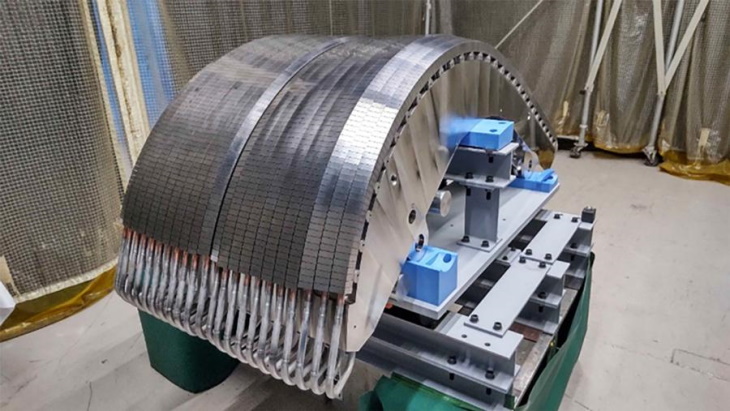
The divertor is one of the core components of the fusion reactor used in the tokamak. It removes the helium ashes in the core plasma produced by the fusion reaction, unburned fuel and other impurities, as well as removing high heat load and particle loading, which are necessary for stable confinement of the plasma. The divertor comprises four parts: the outer vertical target being procured by Japan, the cassette body and inner vertical target being manufactured in the EU, and the dome being made in Russia.
The heat load on the divertor reaches a maximum of 20 MWt per square metre. Since the outer vertical target - which directly faces the plasma due to its structure - is used in an extreme environment where it is exposed to the heat load and high energy particle loading from the plasma, and its structure has an extremely complex shape, high-precision fabrication and processing technology is required.

(Image: MHI)
MHI and QST said they will utilise the technology acquired through the production of this prototype - the manufacture of which began in June 2020 - and apply their full efforts toward manufacturing the units, contributing to the advancement of the ITER project.
In May this year, MHI was awarded a contract by QST to supply a further 12 outer vertical targets for the divertor to be used in ITER. The contract followed the initial production order for the manufacture of six units (Unit 1 - Unit 6) received in 2021. With the additional 12 units (Unit 7 - Unit 18), MHI will manufacture 18 of the total 54 outer vertical targets. The remainder will be manufactured by QST. MHI said production of these units will be completed successively, with delivery to QST expected to begin in 2026.
ITER is a major international project to build a tokamak fusion device in Cadarache, France, designed to prove the feasibility of fusion as a large-scale and carbon-free source of energy. The goal of ITER is to operate at 500 MW (for at least 400 seconds continuously) with 50 MW of plasma heating power input. It appears that an additional 300 MWe of electricity input may be required in operation. No electricity will be generated at ITER.
Thirty-five nations are collaborating to build ITER - the European Union is contributing almost half of the cost of its construction, while the other six members (China, India, Japan, South Korea, Russia and the USA) are contributing equally to the rest. Construction began in 2010 and the original 2018 first plasma target date was put back to 2025 by the ITER council in 2016. However, in June this year, a revamped project plan was announced which aims for "a scientifically and technically robust initial phase of operations, including deuterium-deuterium fusion operation in 2035 followed by full magnetic energy and plasma current operation".